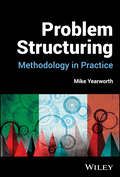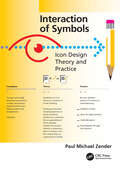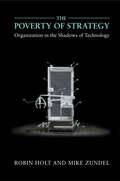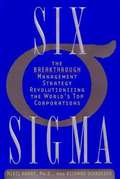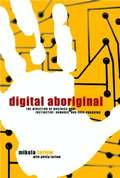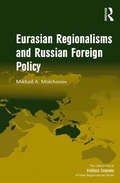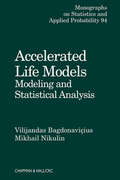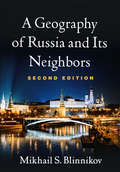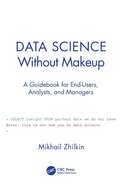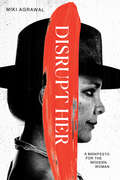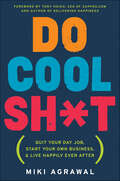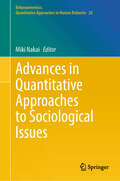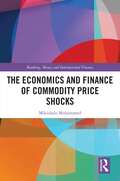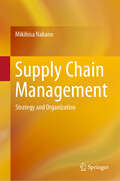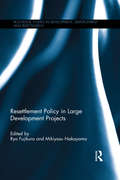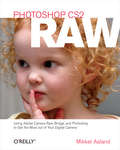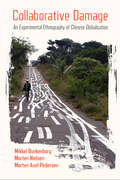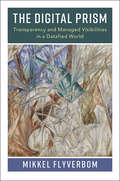- Table View
- List View
Problem Structuring: Methodology in Practice
by Mike YearworthCurrent perspectives on approaches to problem structuring in operational research and engineering and prospects for problem structuring methods applicable to a wide range of practice. Bridging between operational research (OR) and engineering practice, Problem Structuring: Methodology in Practice is grounded in the emergence of soft OR and its development over time as a distinctively new field, broadening the scope of OR to deal with issues of transforming, strategising, and planning in the context of wicked problems. The book is centred on a methodological framing of intervention processes known as problem structuring methods (PSMs) and the techniques presented are suitable for practitioners across a broad range of disciplines. Written by a highly qualified professor of engineering and management, Problem Structuring: Methodology in Practice contains four linked sections that cover: I. Problem formulation when dealing with wicked problems, justification for a methodological approach, the emergence of soft OR, the relevance of pragmatic philosophy to OR practice. II. Traces debates and issues in OR leading to the emergence of soft OR, comparative analysis of PSMs leading to a generic framework for soft OR practice, addressing practical considerations in delivering PSM interventions. III. Charts the emergence of a problem structuring sensibility in engineering practice, introduces a new PSM based on hierarchical process modelling (HPM) supported by teaching and case studies, makes the case for a processual turn in engineering practice supported by HPM with relevance to OR practice. IV. Evaluation of PSM interventions, survey of applications, use of group support systems, new developments supported by machine learning, recontextualising soft OR practice. Problem Structuring: Methodology in Practice is a thought-provoking and highly valuable resource relevant to all “students of problems.” It is suitable for any UK Level 7 (or equivalent) programme in OR, engineering, or applied social science where a reflective, methodological approach to dealing with wicked problems is an essential requirement for practice.
At First Light: A True World War II Story of a Hero, His Bravery, and an Amazing Horse
by Mike Yorkey Walt LarimoreWhat makes 2nd Lieutenant Phil Larimore&’s story special is what happened in World War II&’s closing days and the people—and horses—he interacted with in this Forrest Gump-like tale that is emotional, heartbreaking, and inspiring.Growing up in the 1930s in Memphis, Tennessee, Phil Larimore is the ultimate Boy Scout—able to read maps, put a compass to good use, and traverse wild swamps and desolate canyons. His other great skill is riding horses. Phil does poorly in school, however, leading his parents send to him to a military academy. After Pearl Harbor, Phil realizes he is destined for war. Three weeks before his eighteenth birthday, he becomes the youngest candidate to ever graduate from Officer Candidate School (OCS) at Fort Benning, Georgia. Landing on the Anzio beachhead in February 1944, Phil is put in charge of an Ammunition Pioneer Platoon in the 3rd Infantry Division. Their job: deliver ammunition to the frontline foxholes—a dangerous assignment involving regular forays into No Man&’s Land. As Phil fights his way up the Italian boot, into Southern France and across the Rhine River into Germany, he is caught up in some of the most intense combat ever. But it&’s what happens in the final stages of the war and his homecoming that makes Phil&’s story incredibly special and heartwarming. An emotional tale of courage, daring, and heroism, At First Light will remind you of the indomitable human spirit that lives in all of us.
Interaction of Symbols: Icon Design Theory and Practice
by Mike ZenderInteraction of Symbols is a book for everyone engaged with icon design. It presents a theory of how icons work: symbols in an icon interact to evoke meaning. From this theory flow design principles and practices based on evidence from Design and other disciplines such as Psychology, Perception, and Cognition. The theory, principles, and practices impact how all symbol-based communications are conceived, designed, and applied.The book focuses on icons that elicit a concept without any previous training or use of language. Findings from twenty years’ worth of empirical design research studies explore, illustrate, and support each principle, process, and recommendation. The book begins with a review of icon research from various fields before laying a conceptual foundation that grounds the theory of the book. After and elaborating on that theory are chapters that demonstrate how to Establish Contexts to Guide Comprehension, Glean Which Symbols to Draw, Learn How to Draw Understandable Symbols, Clarify Metaphor, and Use Icons to Decipher Icons in Icon Systems. Written and carefully designed for a broad audience, the book’s scholarly level is elevated while the presentation is approachable. Scholar or professional can skim, scan, or dig, it’s up to them.Heavily illustrated and supported with ample citations, it is not only a book for students and professionals within the field of communication design, but also for anyone who communicates with visual symbols, from healthcare professionals to software engineers, affecting all kinds of graphic communications from advertisements to assembly instructions.
The Poverty of Strategy: Organization in the Shadows of Technology
by Robin Holt Mike ZundelAt least since the ancient Greeks, strategists have sought to direct organized activity through planned, rational decision-making, through the imaginative creation of vision, or through the assertion of will. In all cases, argue Holt and Zundel, strategy impoverishes, not because it only ever offers a partial view, but because it is dedicated to concealing these limits. The situation is exacerbated when machines and algorithms, not humans, organize. Holt and Zundel draw on philosophy, literature, media theory, art, mathematics, computing and military thinking in an attempt to rescue strategy by isolating what, they argue, remains its essence: strategy is a continual organizational struggle towards authenticity. This, too, is a condition of poverty, but one that sets in place an unhomely condition of questionability as opposed to one of efficient predictability. It is, argue Holt and Zundel, the sole gift of strategy to thoughtfully refuse the imperatives being generated by machine relations.
Six Sigma: The Breakthrough Management Strategy Revolutionizing the World's Top Corporations
by Mikel J. Harry Richard SchroederThe best breakthrough management tool for corporations that guides companies to making less mistakes by detecting and correcting defects way before they occur. Six Sigma is known for superior financial results as companies achieve the impossible.
Digital Aboriginal: Instinctive, Nomadic, and Ever-Changing
by Mikela Tarlow Philip TarlowThe Aborigine's view of the world suggests that all things are interconnected. Every relationship in turn influences every other relationship. Along these same lines, this book reveals how the modern-day business world organizes this unlimited range of possibilities and how readers can reorganize and redirect business plans merely by shifting marketing beliefs.
Guidant: Cardiac Rhythm Management Business (A)
by Steven C. Wheelwright Mikelle F. EastleyExamines the choices Guidant must make in research and development spending and new product development. More specifically, CEO Jay Graf considers the payoffs and tradeoffs of using product development skills that he learned in CPI's core business when applied to a complementary business. The company's marketing strategies contribute highly to the discussion.
Eurasian Regionalisms and Russian Foreign Policy (The International Political Economy of New Regionalisms Series)
by Mikhail A. MolchanovBridging foreign policy analysis and international political economy, this volume offers a new look at the problem of agency in comparative regional integration studies. It examines evolving regional integration projects in the Eurasian space, defined as the former Soviet Union countries and China, and the impact that Russian foreign policy has had on integration in the region. Mikhail Molchanov argues that new regionalism in Eurasia should be seen as a reactive response to contemporary challenges that these developing states face in the era of globalization. Regional integration in this part of the world treads the unknown waters and may not simply repeat the early steps in the evolution of the European Union. The question of a hegemonic leadership in particular, as exercised by a country that spearheads regional integration efforts, animates much of the discussion offered in the book. Moreover, Eurasian regionalisms are plural phenomena because of complementary and competing projects that engage the same, or partially overlapping, groups of countries. By combining foreign policy studies with an examination of the international political economy of regionalism in Eurasia the author furthers our understanding of new regionalism, both theoretically and empirically.
Gorbachev: On My Country and the World
by Mikhail GorbachevHere is the whole sweep of the Soviet experiment and experience as told by its last steward. Drawing on his own experience, rich archival material, and a keen sense of history and politics, Mikhail Gorbachev speaks his mind on a range of subjects concerning Russia's past, present, and future place in the world. Here is Gorbachev on the October Revolution, Gorbachev on the Cold War, and Gorbachev on key figures such as Lenin, Stalin, and Yeltsin. The book begins with a look back at 1917. While noting that tsarist Russia was not as backward as it is often portrayed, Gorbachev argues that the Bolshevik Revolution was inevitable and that it did much to modernize Russia. He strongly argues that the Soviet Union had a positive influence on social policy in the West, while maintaining that the development of socialism was cut short by Stalinist totalitarianism. In the next section, Gorbachev considers the fall of the USSR. What were the goals of perestroika? How did such a vast superpower disintegrate so quickly? From the awakening of ethnic tensions, to the inability of democrats to unite, to his own attempts to reform but preserve the union, Gorbachev retraces those fateful days and explains the origins of Russia's present crisis. But Gorbachev does not just train his critical eye on the past. He lays out a blueprint for where Russia needs to go in the next century, suggesting ways to strengthen the federation and achieve meaningful economic and political reforms. In the final section of the book, Gorbachev examines the "new thinking" in foreign policy that helped to end the Cold War and shows how such approaches could help resolve a range of current crises, including NATO expansion, the role of the UN, the fate of nuclear weapons, and environmental problems.Gorbachev: On My Country and the World reveals the unique vision of a man who was a powerful actor on the world stage and remains a keen observer of Russia's experience in the twentieth century.
China’s Infinite Transition and its Limits: Economic, Military and Political Dimensions
by Mikhail Karpov Vasily KashinThis book examines the Chinese model of modernization in three key fields – economic, political and military. The explanations provided here, prepared by Russian analysts, are original because of the authors’ first-hand knowledge of China and their unique professional experience. They share essential insights on China’s model of modernization and its connections to both policy and practice. Focusing on the most vital issues surrounding modernization, and on its impacts on the most important spheres in China, the book offers a valuable asset for the analytical and policy-making community.
Accelerated Life Models: Modeling and Statistical Analysis (Chapman & Hall/CRC Monographs on Statistics and Applied Probability)
by Vilijandas Bagdonavicius Mikhail NikulinThe authors of this monograph have developed a large and important class of survival analysis models that generalize most of the existing models. In a unified, systematic presentation, this monograph fully details those models and explores areas of accelerated life testing usually only touched upon in the literature.Accelerated Life Models:
A Geography of Russia and Its Neighbors, Second Edition
by Mikhail S. BlinnikovAuthoritative yet accessible, the definitive undergraduate text on Russian geography and culture has now been thoroughly revised with the latest data and hot topics, such as the political crisis in Ukraine and the annexation of Crimea and Sevastopol. Thematic chapters provide up-to-date coverage of Russia's physical, political, cultural, and economic geography. Regional chapters focus on the country's major regions and the other 14 former Soviet republics. Written in a lucid, conversational style by a Russian-born international expert, the concise chapters interweave vivid descriptions of urban and rural landscapes, examinations of Soviet and post-Soviet life, deep knowledge of environmental and conservation issues, geopolitical insights, engaging anecdotes, and rigorous empirical data. Over 200 original maps, photographs, and other figures are also available as PowerPoint slides at the companion website, many in color. New to This Edition *Separate chapter on Ukraine and Crimea. *Timely topics--the political crisis in Ukraine and annexation of Crimea and Sevastopol; the return of Putin as president; climate change and environmental degradation; economic slowdown; political shifts in the republics; the role of Russian-backed forces in Syria, Libya, and Central African Republic; changes in Russia–United States relations; and more. *Thoroughly updated population, economic, and political data. *80 new or updated figures, tables, and maps. Pedagogical Features *End-of-chapter review questions, suggested assignments, and in-class exercises. *Within-chapter vignettes about Russian places, culture, and history. *End-of-chapter Internet resources and suggestions for further reading. *Companion website with all figures and maps from the book, many in full color.
Data Science Without Makeup: A Guidebook for End-Users, Analysts, and Managers
by Mikhail Zhilkin"Having worked with Mikhail it does not surprise me that he has put together a comprehensive and insightful book on Data Science where down-to-earth pragmatism is the recurring theme. This is a must-read for everyone interested in industrial data science, in particular analysts and managers who want to learn from Mikhail‘s great experience and approach." --Stefan Freyr Gudmundsson, Lead Data Scientist at H&M, former AI Research Lead at King and Director of Risk Analytics and Modeling at Islandsbanki. "It tells the unvarnished truth about data science. Chapter 2 ("Data Science is Hard") is worth the price on its own—and then Zhilkin gives us processes to help. A must-read for any practitioner, manager, or executive sponsor of data science." --Ted Lorenzen, Director of Marketing Analytics at Vein Clinics of America "Mikhail is a pioneer in the applied data science space. His ability to provide innovative solutions to practical questions in a dynamic environment is simply superb. Importantly, Mikhail’s ability to remain calm and composed in high-pressure situations is surpassed only by his humility." --Darren Burgess, High Performance Manager at Melbourne FC, former Head of Elite Performance at Arsenal FC Mikhail Zhilkin, a data scientist who has worked on projects ranging from Candy Crush games to Premier League football players’ physical performance, shares his strong views on some of the best and, more importantly, worst practices in data analytics and business intelligence. Why data science is hard, what pitfalls analysts and decision-makers fall into, and what everyone involved can do to give themselves a fighting chance—the book examines these and other questions with the skepticism of someone who has seen the sausage being made. Honest and direct, full of examples from real life, Data Science Without Makeup: A Guidebook for End-Users, Analysts and Managers will be of great interest to people who aspire to work with data, people who already work with data, and people who work with people who work with data—from students to professional researchers and from early-career to seasoned professionals. Mikhail Zhilkin is a data scientist at Arsenal FC. He has previously worked on the popular Candy Crush mobile games and in sports betting.
Disrupt-Her: A Manifesto for the Modern Woman
by Miki AgrawalFrom the co-founder of THINX and hellotushy.com, start-ups collectively valued at more than $150 million, comes DISRUPT-HER, a rallying cry for women to radically question the status quo.Miki Agrawal has faced patriarchal pushback, fought girl-on-girl hate, ridden the roller coaster of building businesses as a female CEO, and even overcome an attempt to burn her for witchcraft (figuratively).In order to navigate the complicated--at times maddening--struggles of contemporary femininity, we need an unabashed manifesto for the modern woman that inspires us to move past outrage and take positive steps on the personal, professional, and societal levels.This manifesto galvanizes us to action in 13 major areas of our lives with as much fire power as possible. These are the credos we live by, the advice we give to friends, the tenets we instill in our companies and peers on a daily basis. Stories of badass female movers and shakers are shared in this book too to give you an extra jolt of "I've got this." It's a whole body F*CK YES to your work, your love, your relationships, and your mission--while doing it all authentically, unapologetically, and with full integrity.
Do Cool Sh*t: Quit Your Day Job, Start Your Own Business, and Live Happily Ever After
by Miki AgrawalAn inspiring, irreverent manifesto for those seeking to blaze their own path to entrepreneurship and find fulfillment and happiness through bold action and big ideas.With zero experience and no capital, Miki Agrawal opened WILD, a farm-to-table pizzeria in New York City and Las Vegas, partnered up in a children's multimedia company called Super Sprowtz, and launched a patented high-tech underwear business called THINX.Miki, a successful serial social entrepreneur and angel investor, pulls back the curtain to reveal how you can live out loud, honor your hunches, and leave nothing on the table. Start your business on a shoestring budget, nail your brainstorming sessions and product testing, and get free press coverage—all while living your best life.Whether you’re a recent college graduate trying to find your way in the world, or a professional with a dead-end job and big dreams, Do Cool Sh*t will make you open your eyes, laugh out loud, and shout, "I can do that!"Do Cool Sh*t features a foreword by Tony Hsieh, the founder and CEO of Zappos.
Advances in Quantitative Approaches to Sociological Issues (Behaviormetrics: Quantitative Approaches to Human Behavior #20)
by Miki NakaiThis edited book is the first one in English that demonstrates the innovative use of cutting-edge statistical methods for sociological and social science data. Unlike books that focus solely on applying quantitative methods to sociological and social science data, this book includes in-depth methodological discussions that highlight the interplay between sociological theory and data analysis. With expertise in sociology, psychology, social statistics, and survey methods and data collection, researchers in quantitative social science have developed extended, improved methods such as multivariate statistical analysis, survey methods, cluster analysis, multidimensional scaling, correspondence analysis, latent state model, network analysis, and other means tailored for cross-sectional, longitudinal, compositional, and network data to contribute to solving society's greatest challenges. The purpose of the book is twofold. One is to represent studies focusing on new directions in statistical analysis of sociological and social science data. These new directions may include novel theoretical paradigms, developing topical areas of research, innovative methodologies, and/or substantive findings that explore social processes. The other is to offer the most appropriate models and methods for explaining social phenomena and their underlying structures with the goal of discovering useful information, drawing conclusions, and supporting decision-making. The methodological discussions empower researchers to make informed decisions about research design, data collection, and analysis, enhancing the quality and validity of their sociological inquiries.
Housing Markets and Household Behavior in Japan (Advances in Japanese Business and Economics #19)
by Miki SekoThis book addresses essential questions about housing by building theoretical models based on various real world problems in Japan and testing these models using econometric methods. Almost all related empirical analyses use Japanese household longitudinal data. Accordingly, the author analyzes whole aspects of the data, based on an understanding of the actual situation, theory, and empirical analysis, to directly derive a vision of a future housing policy. Why are houses expensive and difficult to obtain in Japan? Why do people have to live in small houses? Why do people not relocate frequently? Why is the earthquake insurance subscription rate so low, particularly in an earthquake-prone country such as Japan, even after such a catastrophic event as the Great East Japan Earthquake of 2011? How do existing housing finance and tax policies or laws relate to these real world problems? To answer these questions, the book clarifies the unique criteria that characterize housing problems in Japan and presents a vision of future housing policy. The short answer is that existing housing finance policy that adopts criteria based on the floor space of houses creates incentives for people to live in even smaller houses. Furthermore, the Japan Rental Act, which affects people renting homes, reduces residential mobility. The incidence of underinsurance against earthquake risk is a result of earthquake insurance market imperfections such as crude and rough geographical risk ratings. The book elaborates on these factors in four parts and will be of interest to all readers who are concerned with the housing market and household behavior in Japan.
The Economics and Finance of Commodity Price Shocks (Banking, Money and International Finance)
by Mikidadu MohammedThe behaviour of commodity prices never ceases to marvel economists, financial analysts, industry experts, and policymakers. Unexpected swings in commodity prices used to occur infrequently but have now become a permanent feature of global commodity markets. This book is about modelling commodity price shocks. It is intended to provide insights into the theoretical, conceptual, and empirical modelling of the underlying causes of global commodity price shocks. Three main objectives motivated the writing of this book. First, to provide a variety of modelling frameworks for documenting the frequency and intensity of commodity price shocks. Second, to evaluate existing approaches used for forecasting large movements in future commodity prices. Third, to cover a wide range and aspects of global commodities including currencies, rare-hard-lustrous transition metals, agricultural, energy, and health pandemics. Some attempts have already been made towards modelling commodity price shocks. However, most tend to narrowly focus on a subset of commodity markets, i.e., agricultural commodities market and/or energy market. In this book, the author moves the needle forward by operationalizing different models, which allow researchers to identify the underlying causes and effects of commodity price shocks. Readers also learn about different commodity price forecasting models. The author presents the topics to readers assuming less prior or specialist knowledge. Thus, the book is accessible to industry analysts, researchers, undergraduate and graduate students in economics and financial economics, academic and professional economists, investors, and financial professionals working in different sectors of the commodity markets. Another advantage of the book’s approach is that readers are not only exposed to several innovative modelling techniques to add to their modelling toolbox but are also exposed to diverse empirical applications of the techniques presented.
Supply Chain Management: Strategy and Organization
by Mikihisa NakanoThis book explains supply chain management (SCM) using the strategy–structure–process–performance (SSPP) framework. Utilizing this well-known framework of contingency theory in the areas of strategic management and organizational design, SCM is firmly positioned among management theories. The author specifically proposes a theoretical foundation of SCM that will be relevant to such areas as operations management, logistics management, purchasing management, and marketing. Both the static and dynamic sides of SCM are reported. On the static side, supply chain strategies are divided into three patterns: efficiency-oriented, responsiveness-oriented, and the hybrid efficiency- and responsiveness-oriented pattern. For each strategy, suitable internal and external supply chain structures and processes are proposed. On the dynamic side, the big issue is to overcome performance trade-offs. Based on theories of organizational change, process change, and dynamic capabilities, the book presents a model of supply chain process change. On structure, the focus is on the role of an SCM steering department. Illustrative cases are included from such diverse industries as automobiles (Toyota and Nissan ), personal computers (Fujitsu), office equipment (Ricoh), air-conditioning (Daikin), tobacco (Japan Tobacco), chemicals and cosmetics (Kao), and casual fashion (Fast Retailing and Inditex).The strategy and organization of SCM is systematically presented on the basis of the SSPP framework. In particular, the relationships among three management elements—strategy, structure, and process—can be identified in an SCM context. From many of the cases contained in this volume, there emerges an understanding of how to analyze the success and failure factors of SCM using the SSPP framework. In addition, the reader sees not only the static side SCM such as process operation but also its dynamic side such as process innovation and process improvement.
Post-2020 Climate Action
by Shinichiro Fujimori Mikiko Kainuma Toshihiko MasuiThis book summarizes assessments of the Paris Agreement to provide an excellent introduction to this research field. The AIM/CGE (Asia-Pacific Integrated Modeling /Computable General Equilibrium) model, which is the core of AIM modeling framework, is used for the assessment. The first part focuses on global issues, presenting both short-term (a few decades) and long-term (century scale) assessments in the context of the Agreement's ultimate climate goal. It also discusses policy implementation and climate risk. Part 2 is a collection of assessments of individual Asian countries, providing insights into the national situations and detailed analyses. It includes contributions from Asian countries as well as NIES (National Institute for Environmental Studies, Japan) members. The main conclusion is that many countries require changes to their energy systems change and societal transformation in order to meet emissions targets. Part 3 describes in detail the AIM/CGE model, which is used to evaluate the climate and energy policies by simulating the future economic and energy and environmental situation in the Asia-Pacific region. This section can be used as a standard text on CGE modelling in climate change mitigation.
Resettlement Policy in Large Development Projects (Routledge Studies in Development, Displacement and Resettlement)
by Ryo Fujikura Mikiyasu NakayamaHydropower generation by construction of large dams attracts considerable attention as a feasible renewable energy source to meet the power demand in Asian cities. However, large development projects cause involuntary resettlement. Of the world’s forty to eighty million resettlers, many resettlers have been unable to rebuild their livelihood after relocation and have become impoverished. This book uniquely explores the long-term impacts of displacement and resettlement. It shows that long-term post-project evaluation is necessary to assess the rehabilitation and livelihood reconstruction of resettlers after relocation. It focuses on large dam projects in a number of Asian countries, including Indonesia, Japan, Laos, Turkey, Sri Lanka and Vietnam, which are often ignored in Displacement studies in favour of China or India. Drawing on a wealth of empirical data over ten years, it presents crucial factors for successful resettlement by analysing lessons learned. The range of countries allow for a diverse and complex set of factors and outcomes to be analysed. Many of the factors for successful resettlement recur despite the cases being different in implementation period and location. The book presents highly original findings gathered by local researchers in the field directly talking to resettlers who were relocated more than a decade ago. This original book is a unique resource for researchers and postgraduate students of development studies, environment, geography, sociology and anthropology. It also makes policy recommendations for future resettlement programs that are of great value to development policy makers, planners, water resources engineers and civil society protest groups.
Restoring Communities Resettled After Dam Construction in Asia (Routledge Special Issues on Water Policy and Governance)
by Mikiyasu Nakayama and Ryo FujikuraThe rapid economic expansion and population growth of developing countries in Asia has led to increasing demands for water and energy. To meet these demands, large dam development projects have been completed, which has inevitably caused involuntary resettlement. In order to support these projects, dam developers must find appropriate ways to ensure adequate livelihood reconstruction for resettled individuals. Resettlement causes both short-term and long-term effects (both positive and negative) for the relocated populations, meaning that in order to evaluate the larger impact of such projects long-term post-project evaluations must be carried out. However, post-project evaluations by international donors have typically been conducted within a few years after completion; the long-term impact of such projects is seldom evaluated.This book aims to fill this gap. A study team composed of researchers from Indonesia, Japan, Lao PDR, Sri Lanka, and Turkey has conducted ten case studies focusing on resettled individuals satisfaction, opportunities offered, and income generation. The volume provides an overview of the ten case studies, which were carried out across five countries. It also discusses how a compensation programme should be designed and what sort of options should be presented to resettled individuals for their maximum benefit.This book was originally published as a special issue of the International Journal of Water Resources Development.
Photoshop CS2 RAW
by Mikkel AalandThe RAW file format is the uncompressed data file captured by a digital camera's electronic sensor. When your camera saves an image in RAW format, settings like white balance, sharpening, contrast and saturation are not applied to the image but are saved instead in a separate header. Because RAW files remain virtually untouched by in-camera processing, they are essentially the digital equivalent to exposed but undeveloped film. This makes RAW an increasingly popular format with amateur and professional digital photographers, because it affords greater flexibility and control during the editing process-if you know how to work with RAW files. Most digital camera manufacturers supply their own software for converting RAW data, as do some third party vendors. Increasingly, however, the RAW converter of choice is a plug-in included in the latest version of Adobe Photoshop, the most popular and widely-used digital image editing tool in the world. Adobe Photoshop CS2 is emerging as the best place to edit RAW images, and the best way to master this new format is with Photoshop CS2 RAW. An important book dedicated to working with RAW in Photoshop, this comprehensive guide features a unique design that helps readers grasp the subject through visual instruction and prompts. The entire RAW process is explored, from shooting to using the Adobe plug-in converter and new Bridge navigation software. The primary focus of Photoshop RAW is, as the title suggests, Photoshop editing technique: automating RAW workflow, correcting exposures, extending exposure range, manipulating grayscale and working with the new DNG (Digital Negative) open standard that Adobe supports. Presented by photographer Mikkel Aaland, a pioneer of digital photography and author of eight books, including O'Reilly's Photoshop for the Web and the award-winning Shooting Digital, Photoshop CS2 RAW investigates and instructs in an accessible visual style. Required reading for professionals and dedicated photo hobbyists alike.
Collaborative Damage: An Experimental Ethnography of Chinese Globalization
by Morten Axel Pedersen Morten Nielsen Mikkel BunkenborgCollaborative Damage is an experimental ethnography of Chinese globalization that compares data from two frontlines of China's global intervention—sub-Saharan Africa and Inner/Central Asia. Based on their fieldwork on Chinese infrastructure and resource-extraction projects in Mozambique and Mongolia, Mikkel Bunkenborg, Morten Nielsen, and Morten Axel Pedersen provide new empirical insights into neocolonialism and Sinophobia in the Global South.The core argument in Collaborative Damage is that the different participants studied in the globalization processes—local workers and cadres; Chinese managers and entrepreneurs; and the authors themselves, three Danish anthropologists—are intimately linked in paradoxical partnerships of mutual incomprehension. The authors call this "collaborative damage," which crucially refers not only to the misunderstandings and conflicts they observed in the field, but also to their own failure to agree about how to interpret the data. Via in-depth case studies and tragicomical tales of friendship, antagonism, irresolvable differences, and carefully maintained indifferences across disparate Sino-local worlds in Africa and Asia, Collaborative Damage tells a wide-ranging story of Chinese globalization in the twenty-first century.
The Digital Prism: Transparency and Managed Visibilities in a Datafied World
by Mikkel FlyverbomMany people are concerned about the unchecked powers of tech giants and the hidden operations of big data and algorithms. Yet we do not have the vocabularies to properly articulate how these digital transformations shape our lives. This book shows how the management of visibilities - our digital footprints - is a central force in the digital transformation of societies and politics. Seen through the prism of digital technologies and data, the lives of people and structuring of organizations take new shapes in our understanding. Making sense of these requires that we push beyond common ways of thinking about transparency and surveillance, and look at how managing visibilities is a central but overlooked force that influences how people live, how organizations work and how societies and politics operate.
